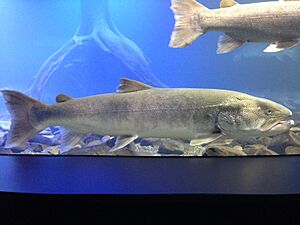Sakhalin taimen facts for kids
Quick facts for kids Sakhalin taimen |
|
|---|---|
 |
|
 |
|
| Conservation status | |
| Scientific classification | |
| Synonyms | |
|
The Sakhalin taimen (Parahucho perryi), also known as the Japanese huchen or stringfish, is a very large type of salmonid fish. It lives in freshwater lakes and big rivers in parts of Northeast Asia. You can find it in Far Eastern Russia, including Primorsky, Khabarovsk, Sakhalin, and the Kuril Islands. It also lives in Hokkaido, Japan. Even though it looks a lot like other "huchen" fish, scientists have found that it's special enough to have its very own group called Parahucho.
Sadly, the number of Sakhalin taimen has been going down for a long time. This is because their homes are being damaged by things like cutting down trees, looking for oil, and changing land into farms. People also catch them by accident when fishing for other fish, or they catch them illegally. Today, there are less than 5% of the fish that used to live in these areas. Because of this, the International Union for Conservation of Nature says the Sakhalin taimen is critically endangered. This means it is at a very high risk of disappearing forever.
Contents
What Does the Sakhalin Taimen Look Like?
The Sakhalin taimen is one of the biggest and oldest types of salmon. It mostly lives in the lower and middle parts of lakes and rivers.
Diet and Size
When these fish are longer than about 30 centimeters (about 1 foot), they mostly eat other fish. Younger Sakhalin taimen, however, prefer to eat insects that live in the water. The average fish caught weighs around 5 kilograms (about 11 pounds). The biggest one ever officially recorded weighed 9.45 kilograms (about 20.8 pounds). There's an old story from Japan about a fish caught in 1937 that was 2.1 meters (almost 7 feet) long!
Reproduction and Life Cycle
Female Sakhalin taimen usually lay between 2,000 and 10,000 eggs in the spring. They lay their eggs on sandy or gravelly river bottoms. It takes about eight years for these fish to grow up and be able to lay eggs themselves. They can lay eggs several times during their lives. Scientists think they can live for about fourteen years.
Where Do Sakhalin Taimen Live?
Sakhalin taimen are found in the Northwest Pacific Ocean region. This includes Sakhalin Island in Russia, Hokkaido Island in Japan, and parts of the far eastern Russian mainland.
Some groups of these fish spend their whole lives in freshwater. Other groups are "anadromous," which means they live in freshwater but travel to the ocean for a while before coming back to freshwater to lay their eggs.
Why Are Sakhalin Taimen in Danger?
The number of Sakhalin taimen around the world has dropped a lot recently. There are many reasons for this.
Habitat Loss
A big problem is that more than half of their original homes have been lost. This is due to farming, cities growing, and more recently, projects to find oil and gas. When their natural homes are destroyed, the fish have nowhere to live or lay their eggs.
Fishing Pressures
Another major problem is that they are often caught by accident. This happens in the big commercial fisheries in Russia and Japan that are trying to catch other types of salmon. This accidental catch is called "bycatch." Also, people sometimes catch them illegally in Russia. Japanese recreational anglers also like to catch these fish as trophies, which adds to the pressure on their numbers.
In Japan, some Sakhalin taimen are raised in special places for sport fishing. You can even buy these raised fish. However, even with these efforts, the species is still critically endangered in the wild.
What is Their Status?
Since 2006, the IUCN (International Union for Conservation of Nature) has listed the Sakhalin taimen as critically endangered. This is based on a study by the Salmonid Specialist Group. This "critically endangered" label means that the species is at the highest possible risk of disappearing from the world. The study showed that the total number of Sakhalin taimen has fallen to less than 5% of what it used to be.


